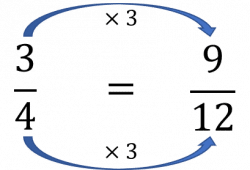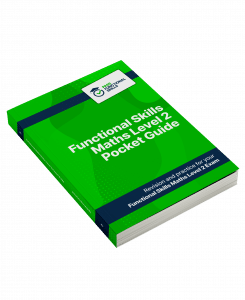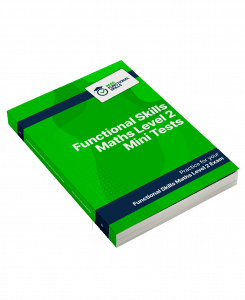Functional Skills: Fractions
Functional Skills: Fractions Revision
Fractions
Fractions are split into the top (called the numerator) and the bottom (called the denominator). The bottom shows the number of total parts and the top shows the number of parts of the total there are. A fraction is just a division.
There 8 skills that you need to learn for fractions.
Make sure you are happy with the following topics before continuing.
See what level 2 maths topics you need support with.
The subject knowledge assessment tests your skills on a number of topics that will come up in the actual exam. You then get feedback on what you need to revise.
Skill 1: Equivalent Fractions
Equivalent fractions are fractions that have different numbers on the top and bottom, but are equal in size.
Example: Write \dfrac{3}{4} as an equivalent fraction with 12 on the bottom.
To go from one fraction to an equivalent fraction, simply multiply or divide the top AND bottom by the same number:

So, \dfrac{3}{4} and \dfrac{9}{12} are equivalent fractions.
Skill 2: Simplifying Fractions
To simplify a fraction, repeatedly divide the top of the fraction and the bottom of the fraction by the same amount, until they can no longer be divided to make whole numbers.
Note: A simplified fraction is just an equivalent fraction to the original one, so they are both equal in size.
Example: Write the fraction \dfrac{18}{30} in its simplest form.
\textcolor{red}{18} and \textcolor{red}{30} are both divisible by 6.
\dfrac{18}{30}= \dfrac{18\div6}{30\div6} = \textcolor{black}{\dfrac{3}{5}}
3 and 5 cannot both be divided, so the fraction is in its simplest form.
Follow Our Socials
Our Facebook page can put you in touch with other students of your course for revision and community support. Alternatively, you can find us on Instagram or TikTok where we're always sharing revision tips for all our courses.
Skill 3: Writing Numbers as a Fraction of Another
Example: Write \textcolor{red}{40} as a fraction of \textcolor{blue}{50}. Give your answer in its simplest form.
Write the first number, \textcolor{red}{40}, on the top and the second number, \textcolor{blue}{50}, on the bottom:
\dfrac{\textcolor{red}{40}}{\textcolor{blue}{50}}
Then, simplify the fraction fully:
\dfrac{\textcolor{red}{40} \div 10}{\textcolor{blue}{50} \div 10} = \dfrac{4}{5}
Skill 4: Fractions of Amounts
To calculate a fraction of an amount, divide the amount by the bottom of the fraction and then multiply it by the top, or the other way around.
Example: Calculate \dfrac{\textcolor{blue}{2}}{\textcolor{red}{5}} of \textcolor{limegreen}{£240}.
‘Of‘ means that we multiply \dfrac{2}{5} by £240
First divide \textcolor{limegreen}{£240} by \textcolor{red}{5} and then multiply it by \textcolor{blue}{2}:
\begin{aligned} \dfrac{2}{5} \text{ of } £240 &= (\textcolor{limegreen}{£240} \div \textcolor{red}{5}) \times \textcolor{blue}{2} \\ &= £48 \times \textcolor{blue}{2} \\ & = £96 \end{aligned}
Skill 5: Adding and Subtracting Fractions
To add or subtract fractions, they need to have the same bottom number (they need to have a common denominator). If the fractions do not have the same bottom number, then you need to turn them into equivalent fractions with the same number on the bottom. Then you simply add or subtract the top numbers.
Example: Solve \dfrac{2}{5} + \dfrac{1}{4}
Turn them into equivalent fractions with the same number on the bottom:
\dfrac{2}{5}=\dfrac{2\times 4}{5\times 4}=\dfrac{8}{20}
\dfrac{1}{4}=\dfrac{1\times5}{4\times 5}=\dfrac{5}{20}
Now, add the tops of the fractions together:
\dfrac{2}{5} + \dfrac{1}{4}=\dfrac{8}{20} + \dfrac{5}{20}= {\dfrac{13}{20}}
Note: A subtraction is done in the same way, except you subtract the top numbers at the end.
Skill 6: Converting between Improper Fractions and Mixed Numbers
An improper fraction is a fraction where the top number is bigger than the bottom number, e.g. \dfrac{7}{4}
A mixed number is the mix of a whole number and a fraction, e.g. 3 \dfrac{2}{5}
Improper fractions and mixed numbers can be converted between.
Example 1: Write \dfrac{\textcolor{red}{25}}{\textcolor{limegreen}{4}} as a mixed number.
A fraction is just a division. So,
\dfrac{\textcolor{red}{25}}{\textcolor{limegreen}{4}} = \textcolor{red}{25} \div \textcolor{limegreen}{4}
You can use the bus stop method, to find that
\textcolor{red}{25} \div \textcolor{limegreen}{4} = \textcolor{blue}{6} \text{ r } \textcolor{orange}{1}
Then, the number on top of the “bus stop” (the whole number part) is the number before the fraction, and the remainder goes on top with the dividing number on the bottom:
\dfrac{\textcolor{red}{25}}{\textcolor{limegreen}{4}} = \textcolor{blue}{6} \dfrac{\textcolor{orange}{1}}{\textcolor{limegreen}{4}}
Example 2: Write \textcolor{red}{5} \dfrac{\textcolor{orange}{2}}{\textcolor{purple}{3}} as an improper fraction.
When converting from a mixed number to an improper fraction, we need to multiply the whole number by the bottom and add it to the top.
Whole number multiplied by the bottom:
\textcolor{red}{5} \times \textcolor{purple}{3} = 15
Add this to the top:
15 + \textcolor{orange}{2} = \textcolor{blue}{17}
Then, this number goes above the bottom number of the original fraction part:
\textcolor{red}{5} \dfrac{\textcolor{orange}{2}}{\textcolor{purple}{3}} = \dfrac{\textcolor{blue}{17}}{\textcolor{purple}{3}}
Skill 7: Adding and Subtracting Mixed Numbers
You can add and subtract mixed numbers using the skills you have already learned to add and subtract fractions and convert between mixed numbers and improper fractions.
Example: Calculate 2 \dfrac{3}{4} + 3\dfrac{1}{2}
Step 1: Split up the whole number parts and fraction parts separately:
2 \dfrac{3}{4} + 3\dfrac{1}{2} = \textcolor{limegreen}{2 + 3} + \textcolor{red}{\dfrac{3}{4} + \dfrac{1}{2}}
Step 2: Add the numbers, then add the fractions:
\textcolor{limegreen}{2 + 3} = \textcolor{limegreen}{5} and \textcolor{red}{\dfrac{3}{4} + \dfrac{1}{2}} = \dfrac{3}{4} + \dfrac{2}{4} = \dfrac{5}{4} = \textcolor{red}{1 \dfrac{1}{4}}
Step 3: Finally, add the parts together:
\textcolor{limegreen}{5} + \textcolor{red}{1 \dfrac{1}{4}} = 6 \dfrac{1}{4}
Note: A subtraction is done in the same way, except you need to subtract the parts instead of adding. You still add the parts back together at the end though!
Improve your chances of passing your functional skills maths exam.
Take a subject knowledge assessment and understand what topic areas you need to work on to ensure you pass for level 2 maths exam first time.
Skill 8: Comparing Fractions
All types of fractions can be compared, whether they have different numbers on the bottom, or they are improper fractions or mixed numbers. We can determine which ones are bigger and put them in order of size by converting between mixed numbers and improper fractions and using equivalent fractions.
Example: What is bigger, \dfrac{7}{5} or 1 \dfrac{1}{3}?
Step 1: The fractions need to be in the same form, so convert 1 \dfrac{1}{3} into an improper fraction, as these are easier to compare than mixed numbers:
1 \dfrac{1}{3} = \dfrac{4}{3}
Step 2: The bottom numbers are different, so you need to find equivalent fractions:
3 \times 5 = \textcolor{limegreen}{15} so multiply the top and bottom of each fraction to get \textcolor{limegreen}{15} on the bottom.
\dfrac{7}{5} = \dfrac{7 \times 3}{5 \times 3} = \dfrac{\textcolor{red}{21}}{\textcolor{limegreen}{15}} and \dfrac{4}{3} = \dfrac{4 \times 5}{3 \times 5} = \dfrac{\textcolor{blue}{20}}{\textcolor{limegreen}{15}}
Step 3: Finally, compare the size of the top of the fractions:
\textcolor{red}{21} is bigger than \textcolor{blue}{20}, so \dfrac{7}{5} is bigger than 1 \dfrac{1}{3}
Notes:
When doing fractions on a calculator, if it doesn’t have a fraction button then you can use the divide (\div) button instead. This will turn the fraction into a decimal, and then you can use these conversions to calculate your answers (see Fractions, Decimals and Percentages).
e.g. Calculate \dfrac{182}{260} - \dfrac{45}{75}
\dfrac{182}{260} = 182 \div 260 = 0.7 and \dfrac{45}{75} = 45 \div 75 = 0.6
So,
\dfrac{182}{260} - \dfrac{45}{75} = 0.7 - 0.6 = 0.1
Then, convert this to a fraction,
0.1 = \dfrac{10}{100} = \dfrac{1}{10}
Functional Skills: Fractions Example Questions
Question 1: Write \dfrac{27}{30} in its simplest form.
[1 mark]
27 and 30 are both divisible by 3
\dfrac{27 \div 3}{30 \div 3} = \dfrac{9}{10}
9 and 10 cannot both be divided, so the fraction is in its simplest form.
Question 2: There are 28000 people in a stadium. \dfrac{2}{7} of the people are children. How many people in the stadium are children?
[1 mark]
First, divide by 7 and then multiply by 2:
28000\div7 = 4000
4000 \times 2 = 8000
So, there are 8000 children in the stadium.
Question 3: Calculate \dfrac{7}{10} - \dfrac{7}{3}
Give your answer as a fraction in its simplest form.
[2 marks]
Multiply the top and bottom of the first fraction by 3, and multiply the top and bottom of the second fraction by 10, so that they have the same bottom number,
\dfrac{7}{10} - \dfrac{7}{3} = \dfrac{21}{30} - \dfrac{70}{30} = -\dfrac{49}{30}
Question 4: Calculate 3 \dfrac{1}{5} - 1 \dfrac{3}{4}
Give your answer as an improper fraction in its simplest form.
[2 marks]
Split up the whole number parts and fraction parts separately:
3 \dfrac{1}{5} - 1 \dfrac{3}{4} = (3 - 1) + \left(\dfrac{1}{5} - \dfrac{3}{4} \right)
Subtract the numbers, then subtract the fractions:
3-1 = 2 and \dfrac{1}{5} - \dfrac{3}{4} = \dfrac{4}{20} - \dfrac{15}{20} = - \dfrac{11}{20}
Finally, add the parts together:
2 + \left(- \dfrac{11}{20} \right) = 2 - \dfrac{11}{20} = \dfrac{40}{20} - \dfrac{11}{20} = \dfrac{29}{20}
Question 5: Put the following fractions in order of size, from smallest to largest.
\dfrac{17}{20}, \dfrac{87}{100}, \dfrac{4}{5}, \dfrac{44}{50}
[2 marks]
The bottom numbers are different, so you need to find equivalent fractions. Each fraction can be turned into an equivalent fraction with 100 on the bottom, for easy comparison,
\dfrac{17}{20} = \dfrac{17 \times 5}{20 \times 5} = \dfrac{85}{100}
\dfrac{87}{100}
\dfrac{4}{5} = \dfrac{4 \times 20}{5 \times 20} = \dfrac{80}{100}
\dfrac{44}{50} = \dfrac{44 \times 2}{50 \times 2} = \dfrac{88}{100}
Then, we can compare the top numbers, and order the fractions from smallest to largest:
\dfrac{80}{100}, \dfrac{85}{100}, \dfrac{87}{100}, \dfrac{88}{100}
Finally, convert these fractions back to their original form, keeping them in order from smallest to largest:
\dfrac{4}{5}, \dfrac{17}{20}, \dfrac{87}{100}, \dfrac{44}{50}
Functional Skills: Fractions Worksheet and Example Questions
Fractions L1
FS Level 1NewOfficial PFSFractions L2
FS Level 2NewOfficial PFS[responsive-flipbook id=”pfs_pocket_revision_guide_-_sample”]
Revision Products

Functional Skills Maths Level 2 Pocket Revision Guide
Revise and practice for your functional skills maths level 2 exam. All topics covered in this compact revision guide.

Functional Skills Maths Level 2 Mini Tests
Practice for your functional skills Maths level 2, questions from every topic included.

Functional Skills Maths Level 2 Revision Cards
Revise for functional skills maths level 2 easily and whenever and wherever you need. Covering all the topics, with revision, questions and answers for every topic.

Functional Skills Maths Level 2 Practice Papers
This 5 set of Functional Skills Maths Level 2 practice papers are a great way to revise for your Functional Skills Maths Level 2 exam. These practice papers have been specially tailored to match the format, structure, and question types used by each of the main exam boards for functional skills Maths. Each of the 5 papers also comes with a comprehensive mark scheme, so you can see how well you did, and identify areas to improve on.

Functional Skills Maths Level 2 Practice Papers & Revision Cards
This great value bundle enables you to get 5 functional skills maths level 2 practice papers along with the increasingly popular flashcard set that covers the level 2 content in quick fire format.





